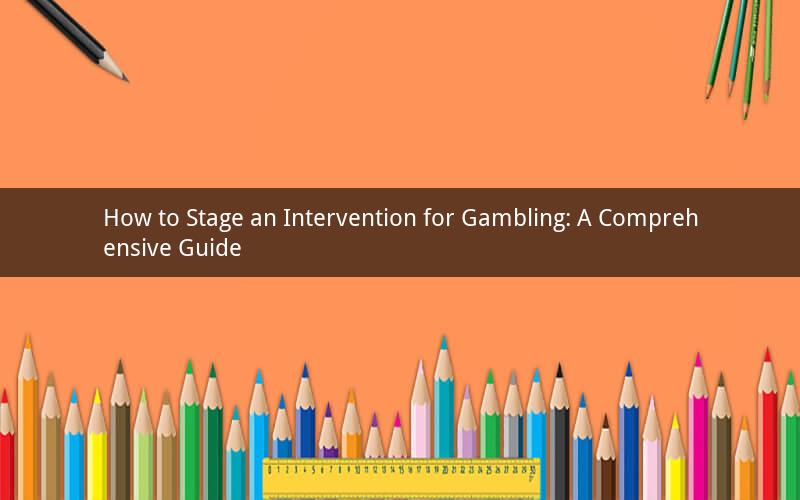
Introduction:
Gambling addiction is a significant issue affecting individuals and their families. An intervention can be a crucial step towards helping someone overcome their gambling problem. This guide will provide you with a comprehensive overview of how to stage an intervention for gambling, including the preparation, the actual intervention, and the aftermath.
1. Understanding the Problem:
Before staging an intervention, it is essential to have a clear understanding of the gambling addiction. Familiarize yourself with the signs and symptoms of gambling addiction, such as financial difficulties, neglecting responsibilities, and lying about gambling activities. Recognize that gambling addiction is a chronic condition that requires professional help.
2. Assemble the Intervention Team:
The intervention team should consist of individuals who are close to the person struggling with gambling addiction. This may include family members, friends, colleagues, or a combination of these. Ensure that everyone involved is committed to supporting the individual and willing to participate in the intervention.
3. Research and Prepare:
Research treatment options and recovery resources available in your area. This will help you provide the individual with valuable information during the intervention. Prepare a list of specific examples that demonstrate the impact of the gambling addiction on the individual and their loved ones.
4. Set a Date and Location:
Choose a date and location for the intervention that is convenient for everyone involved. Ensure that the location is private and comfortable, allowing for an open and honest discussion. Avoid selecting a place that may trigger gambling-related emotions or associations.
5. Create a Structure for the Intervention:
Develop a structured plan for the intervention. Begin with an introduction, followed by each team member sharing their concerns and experiences. Allow the individual to respond and express their feelings. Conclude the intervention with a clear plan for seeking help and supporting the individual during their recovery journey.
6. Open the Intervention:
Start the intervention by expressing your love and concern for the individual. Emphasize that the purpose of the intervention is to support them in overcoming their gambling addiction, not to judge or shame them. Use “I” statements to avoid sounding accusatory.
7. Share Concerns and Experiences:
Each team member should take turns sharing their concerns and experiences related to the individual's gambling addiction. Be specific and provide examples that illustrate the impact on the individual and their loved ones. Avoid dwelling on past mistakes or failures.
8. Allow the Individual to Respond:
After each team member has shared their concerns, give the individual an opportunity to respond. Encourage them to express their feelings, thoughts, and reasons for gambling. Listen actively and empathetically, without interrupting or contradicting them.
9. Offer Support and Encouragement:
During the intervention, emphasize the support and encouragement available to the individual. Discuss treatment options, support groups, and other resources that can assist them in their recovery journey. Reiterate your commitment to supporting them throughout the process.
10. Conclude the Intervention:
Conclude the intervention by summarizing the main points discussed. Offer a clear plan for seeking help, including contacting treatment professionals or attending support groups. Encourage the individual to take the first step towards recovery and assure them that you will be there to support them every step of the way.
11. Follow Up and Support:
After the intervention, it is crucial to follow up and provide ongoing support. Encourage the individual to seek professional help and attend treatment programs. Attend support group meetings or counseling sessions together if possible. Continue to offer your love, understanding, and encouragement throughout their recovery journey.
Q1: What are the signs and symptoms of gambling addiction?
A1: Signs and symptoms of gambling addiction may include financial difficulties, neglecting responsibilities, lying about gambling activities, increased time spent on gambling, and a preoccupation with gambling thoughts.
Q2: How can I ensure that the intervention is successful?
A2: To ensure the success of the intervention, gather a supportive team, research treatment options, and prepare a structured plan. Maintain a non-judgmental attitude, listen actively, and offer ongoing support after the intervention.
Q3: Can I stage an intervention for someone who has already sought help for their gambling addiction?
A3: Yes, you can still stage an intervention even if the individual has already sought help. The intervention can serve as an opportunity to reinforce their commitment to recovery and provide additional support.
Q4: How long does an intervention typically last?
A4: The duration of an intervention can vary, but it generally ranges from 30 minutes to an hour. The key is to keep the conversation focused and concise while allowing enough time for everyone to share their concerns and experiences.
Q5: What should I do if the individual refuses to participate in the intervention?
A5: If the individual refuses to participate in the intervention, it is essential to remain patient and understanding. Consider seeking professional advice from a therapist or counselor who can help you navigate this situation and provide guidance on how to approach the individual.